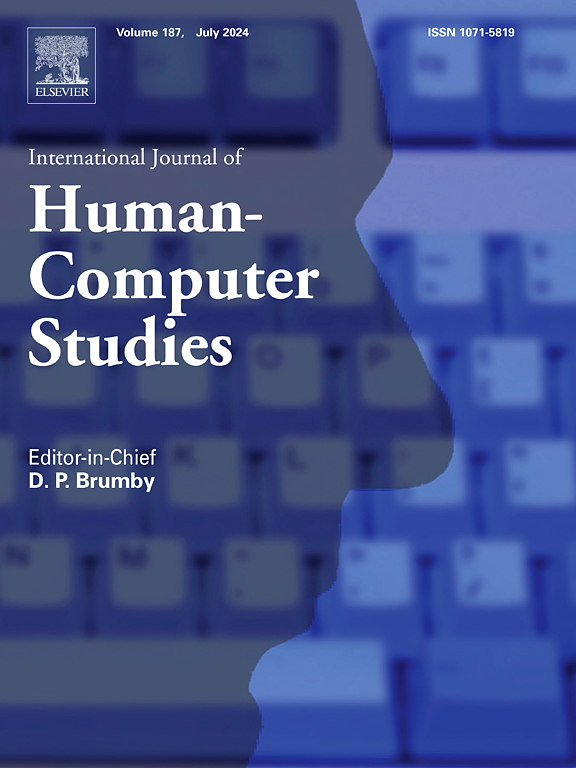人工智能生成的视障儿童触觉图形:多模态教育产品的可用性研究
IF 5.3
2区 计算机科学
Q1 COMPUTER SCIENCE, CYBERNETICS
International Journal of Human-Computer Studies
Pub Date : 2025-04-21
DOI:10.1016/j.ijhcs.2025.103525
引用次数: 0
摘要
全世界大约有7000万0-14岁的儿童患有视觉障碍,由于缺乏视觉输入,他们的语言习得和图像识别能力受到限制。人机交互技术提供了通过触摸和听觉刺激学习盲文和图像的机会,取代了传统的视觉输入元素。然而,有效地整合这些感官输入仍然是一个挑战。为了解决这个问题,我们开发了“TaleVision”,这是一种使用大型语言模型立即生成可触摸图像和声音效果的产品,让视障儿童更好地理解盲文和图像之间的联系。我们招募了5名视力正常的儿童和14名先天性视力障碍的儿童来测试我们的产品。几乎所有的参与者都报告了很高的满意度,并高度评价了用户体验。此外,我们还观察了视障儿童和教师如何与我们的产品互动,以改善教学。根据结果,我们讨论了最佳设计实践、流程建议和潜在的未来解决方案。本文章由计算机程序翻译,如有差异,请以英文原文为准。
AI-generated tactile graphics for visually impaired children: A usability study of a multimodal educational product
Approximately 70 million children aged 0–14 worldwide have visual impairments, limiting their language acquisition and image recognition development due to a lack of visual input. Human-computer interaction technologies provide an opportunity to learn Braille and images through touch and auditory stimuli, replacing traditional visual input elements. However, effectively integrating these sensory inputs remains a challenge. To address this, we developed "TaleVision," a product that uses large language models to instantly generate touchable images and sound effects, allowing visually impaired children to better understand the connection between Braille and images. We recruited five sighted children and 14 children with congenital visual impairments to test our product. Almost all participants reported high satisfaction and rated the user experience highly. Additionally, we also observed how visually impaired children and teachers interacted with our products to improve teaching and learning. Based on the results, we discussed best design practices, process recommendations, and potential future solutions.
求助全文
通过发布文献求助,成功后即可免费获取论文全文。
去求助
来源期刊

International Journal of Human-Computer Studies
工程技术-计算机:控制论
CiteScore
11.50
自引率
5.60%
发文量
108
审稿时长
3 months
期刊介绍:
The International Journal of Human-Computer Studies publishes original research over the whole spectrum of work relevant to the theory and practice of innovative interactive systems. The journal is inherently interdisciplinary, covering research in computing, artificial intelligence, psychology, linguistics, communication, design, engineering, and social organization, which is relevant to the design, analysis, evaluation and application of innovative interactive systems. Papers at the boundaries of these disciplines are especially welcome, as it is our view that interdisciplinary approaches are needed for producing theoretical insights in this complex area and for effective deployment of innovative technologies in concrete user communities.
Research areas relevant to the journal include, but are not limited to:
• Innovative interaction techniques
• Multimodal interaction
• Speech interaction
• Graphic interaction
• Natural language interaction
• Interaction in mobile and embedded systems
• Interface design and evaluation methodologies
• Design and evaluation of innovative interactive systems
• User interface prototyping and management systems
• Ubiquitous computing
• Wearable computers
• Pervasive computing
• Affective computing
• Empirical studies of user behaviour
• Empirical studies of programming and software engineering
• Computer supported cooperative work
• Computer mediated communication
• Virtual reality
• Mixed and augmented Reality
• Intelligent user interfaces
• Presence
...
 求助内容:
求助内容: 应助结果提醒方式:
应助结果提醒方式:


